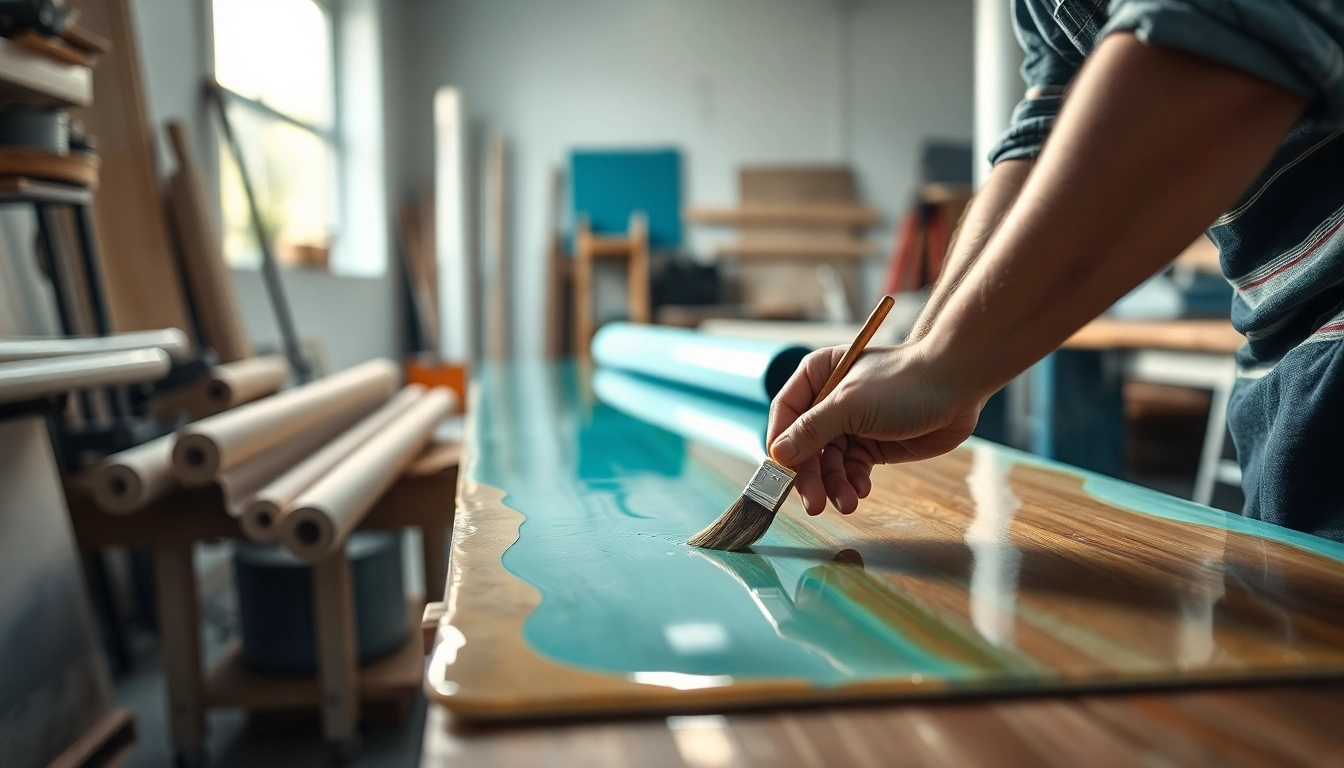Understanding Laminating Resin
What is Laminating Resin?
Laminating resin is a type of synthetic resin used primarily for bonding materials together to create a durable and stable composite structure. It plays a pivotal role in various industries, including marine, automotive, construction, and crafts. Essentially, laminating resin serves as a matrix that encapsulates fibers, such as fiberglass or carbon, to produce lightweight yet strong materials. The two most common forms of laminating resins are polyester and epoxy, each offering distinct properties and advantages tailored for specific applications.
The function of laminating resin is crucial in the fabrication of composite materials. For example, it adheres layers of fiberglass together, enabling the creation of reinforced structures essential for boat hulls, aircraft components, and sporting equipment. The use of laminating resin simplifies the construction process while enhancing the performance of finished products.
For detailed information on different types and applications of laminating resin, we dive deeper into the characteristics and benefits further in this article.
Key Properties and Benefits
The selection of a laminating resin is often influenced by its properties, which directly correlate to its performance in specific applications. Here are some of the key properties of laminating resins:
- Adhesion: High adhesion qualities ensure that the fibers are effectively bonded, improving the durability of the composite material.
- Flexibility: Ideal laminating resin maintains adequate flexibility, accommodating stress and preventing cracking during use.
- UV Resistance: Some laminating resins are formulated to resist degradation from UV exposure, making them suitable for outdoor applications.
- Heat Resistance: Certain formulations can withstand elevated temperatures devoid of losing structural integrity, suitable for automotive and aerospace industries.
- Fast Curing: Rapid curing options are available, enabling quicker turnaround times in production settings.
These properties allow manufacturers to choose laminating resins that cater to the specific needs of their projects, balancing performance and cost efficiency effectively.
Common Applications of Laminating Resin
Laminating resins find applications across a broad spectrum of industries due to their versatility and strength. Here are some of the most prevalent uses:
- Boating Industry: Laminating resins are extensively used in the construction of hulls for boats and yachts, where water resistance and strength are critical.
- Automotive Components: Lightweight composite materials made with laminating resins are used in car body panels and structural components, helping enhance fuel efficiency by reducing weight.
- Construction: Laminating resins are employed for creating durable structural elements and as coatings to enhance the longevity of buildings.
- Sports Equipment: From surfboards to bicycles, laminating resin is essential in manufacturing high-performance gear that withstands rigorous use.
Types of Laminating Resin
Polyester Laminating Resin Overview
Polyester laminating resin is one of the most commonly used resins in various applications, specifically in the marine and automotive industries. It is generally appreciated for its cost-effectiveness, ease of use, and good mechanical properties.
This resin is commonly combined with glass fibers to create robust composite structures. Among its advantages are its excellent resistance to moisture and many chemicals, making it ideal for marine applications where exposure to water is constant.
Epoxy Laminating Resin Characteristics
Epoxy laminating resin offers superior strength compared to polyester resins and is favored in applications where adhesion and structural performance are paramount. It exhibits a lower tendency to shrink during curing, leading to a better fit and finish.
Epoxy resins also perform better in terms of heat resistance and chemical resistance, making them suitable for high-performance applications. While generally more expensive than polyester, their properties and performance make them the preferred choice for many industrial applications, including aerospace and automotive sectors.
Comparative Analysis of Laminating Resins
When choosing between polyester and epoxy laminating resin, consider the following comparisons:
| Property | Polyester | Epoxy |
|---|---|---|
| Cost | Less expensive | More expensive |
| Adhesion | Moderate | High |
| Flexibility | Moderate | Higher |
| Heat Resistance | Lower | Higher |
| Curing Time | Faster | Variable |
Choosing the Right Laminating Resin
Factors to Consider in Selection
Selecting the appropriate laminating resin requires careful consideration of several factors:
- Application Requirements: Determine the end use of the composite material and the conditions it will face; this will help dictate whether polyester or epoxy is most suitable.
- Cure Time: Assess how quickly you need the resin to cure and whether you need a faster setup or can accommodate longer working times for more complex applications.
- Cost Considerations: Balance the budget against performance requirements, considering how critical strength and adhesion are to the finished product.
- Environmental Impact: Consider any sustainability factors or regulatory requirements that may affect resin selection.
Matching Resin to Application
The decision on whether to use polyester or epoxy laminating resin can often hinge on the application itself. For example, while polyester may suffice for less demanding projects such as crafts or general-purpose repairs, epoxy is often necessary for spaces where strength and environmental exposure are significant concerns.
It’s vital to conduct a requirements analysis to ensure optimal performance and lifespan of the end product.
Packing and Storage Recommendations
Proper packing and storage of laminating resins are critical to maintain their integrity. Here are some best practices:
- Store resin in a cool, dry place away from direct sunlight to prevent degradation.
- Ensure that containers are tightly sealed to avoid contamination and moisture ingress.
- Label containers with the resin type and date of purchase for easier inventory management.
Application Techniques for Laminating Resin
Preparation of Fiberglass and Tools
Preparing fiberglass and tools is an essential step in achieving optimal results when working with laminating resin. Begin by ensuring that the fiberglass is clean, dry, and free from dust or contaminants. If necessary, sand the surface to promote adhesion between layers.
Additionally, select appropriate tools such as rollers, brushes, and mixing containers that are compatible with the resin. Choosing the right tools can significantly ease the application process and improve the results.
Step-by-Step Application Process
The application of laminating resin follows these general steps:
- Mix the Resin: If you’re using a two-part resin system, mix the resin and hardener according to the manufacturer’s instructions.
- Prepare the Surface: Ensure that the surfaces you are bonding or laminating are clean and prepped as discussed earlier.
- Apply the Resin: Use a brush or roller to evenly apply an initial layer of resin onto the surface, followed by placing the fiberglass.
- Layering: Repeat the process for additional layers as required, ensuring the resin remains tacky for the best adhesion between layers.
- Cure the Resin: Allow sufficient time for the resin to cure per the manufacturer’s recommendations before handling the laminated object.
Troubleshooting Common Issues
Even experienced users can encounter issues when applying laminating resin. Some common problems include:
- Blistering: Often caused by moisture in the fiberglass or improperly mixed resin. Ensure surfaces are dry before application.
- Poor Adhesion: Insufficient curing time or contamination can lead to weak bonds. Follow recommended guidelines carefully.
- Surface Imperfections: Sanding between coats can mitigate this issue and provide a smoother finish.
Maintaining Laminated Surfaces
Best Practices for Care and Maintenance
Maintaining laminated surfaces enhances their longevity and performance. Regular cleaning with mild detergent and water is recommended to remove debris and prevent build-up that could weaken the resin over time.
Inspecting for cracks or signs of wear periodically allows for early detection of potential issues, enabling timely repairs.
Repairing Damages in Laminated Products
If a laminated product sustains damage, it is essential to repair it promptly. Begin by cleaning the damaged area and removing any loose material. For minor cracks or chips, apply a patch of fiberglass cloth saturated with laminating resin above the affected area.
For more extensive damage, consider replacing the entire layer of fiberglass. Always follow proper repair protocols to maintain structural integrity.
Long-term Performance and Sustainability
The longevity of laminated products often hinges on the proper selection, application, and maintenance of the laminating resin.
When selected correctly, laminating resins offer high performance and can withstand various environmental conditions. Additionally, with the emergence of bio-based and low-VOC resins, there are sustainable options that provide excellent performance while reducing environmental impact.



